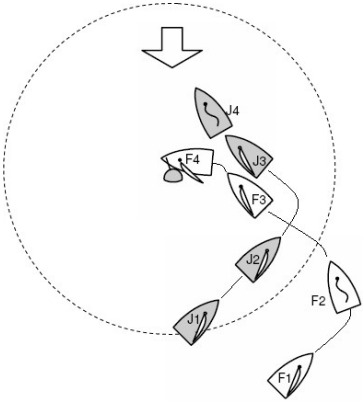When Jagga reached the zone she was overlapped inside Freebird. From
that time until Freebird turned past head to wind, rule 18.2(b) required
Freebird to give Jagga mark-room. When Freebird turned past head to
wind, the boats were on opposite tacks on a beat to windward, and so rule
18 ceased to apply (see rule 18.1(a)). After Freebird completed her tack, she
had right of way under rule 10, but initially she was subject to rule 15. She
complied with that rule because Jagga had room to keep clear by crossing
ahead of her.
Between positions 2 and 3 Jagga passed head to wind and was then on the
same tack as Freebird. At that time Jagga was fetching the mark and
Freebird had been on starboard tack since entering the zone, so rule 18.3
began to apply. While rule 18.3 applied, rule 18.2 did not. However, a short
time later when Jagga completed her tack, Freebird was overlapped inside
her, and Jagga was required by rule 18.3 to give Freebird mark-room.
After Jagga crossed ahead of Freebird, Freebird had right of way, first
under rule 10, then under rule 13 and finally under rule 11. Therefore, Jagga
had no protection from rule 15 during that time.
After position 3, rule 11 required Jagga to sail so that Freebird could ‘sail
her course with no need to take avoiding action’ (see the definition Keep
Clear). The fact that, when Jagga luffed, Freebird had to change course to
avoid contact was evidence that Jagga broke rule 11 by not keeping clear.
Also, when Jagga luffed she did not give Freebird space to sail to the mark
and comply with her obligation under rule 31. Therefore, Jagga broke rule
18.3 (see also the definitions Mark-Room and Room).
The protest committee correctly disqualified Jagga under rule 18.3, but she
also broke rule 11. Freebird broke rule 31 when she touched the mark, but
she was exonerated by rule 43.1(b). Jagga’s appeal is dismissed.
|
